Thinking about walking the Via Francigena and want to know where to stay in Via Francigenaalong your route? Then keep reading and find out all about where to stay during your walking holiday on the Via Francigena. This centuries-old Camino of Italy crosses 4 countries to finally end in the eternal city of Rome. So good to take into account the different accommodation you will encounter during your Via Francigena.
Types of Accommodation Along the Route
As this pilgrimage route passes through different countries and surroundings, you will come across many places where to stay in Via Francigena. There is something for everyone, and also a suitable place to stay for every budget. Where some prefer luxury to the basic, others go for the local places to stay and others will opt for authentic accommodation or cute little gems.
The choice where to stay in Via Francigena is very varied, but what they all have in common is that you will be welcomed with open arms. And they all do their best to make your pilgrim walking holiday a unique experience.
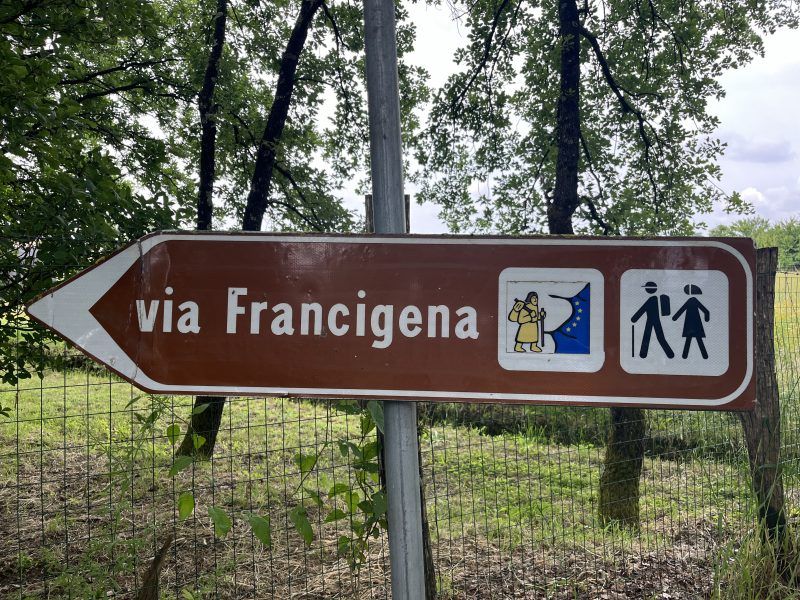
Pilgrim hostels/Pensions
The real pilgrim feeling you get once you stay times your Via Francigena in a hostel, also called ‘Ostello per Pellegrini’ in Italian. These are common in both France and Italy. The advantage is that they are cheap. (A Dutch person likes that). In addition, you are welcomed with open arms in the accommodation, which is often located on the pilgrim route itself.
And finally, here too: shared sorrow is half sorrow. Because there is nothing better than sharing stories, tips and experiences with other pilgrims during the common evening meal. That way, you create a bond and your Via Francigena becomes that little bit more special.
Bed & Breakfast
When walking a pilgrimage route through England, a B&B should not be missing from the list, of course. They provide just the right touch of cosiness during your pilgrimage on the Via Francigena. There is more comfort to be found, you are often treated to home-made delicacies and you also have a bit more privacy than in the aforementioned hostels. You’ll pay a price for that, of course.
We do recommend booking these cosy places in advance, though. They are in demand, which means you are not the only one who wants to sleep in a B&B during your walking holiday. Luckily, they can be found in England as well as France, Switzerland and Italy. Or rather, in all the countries the Via Francigena crosses.
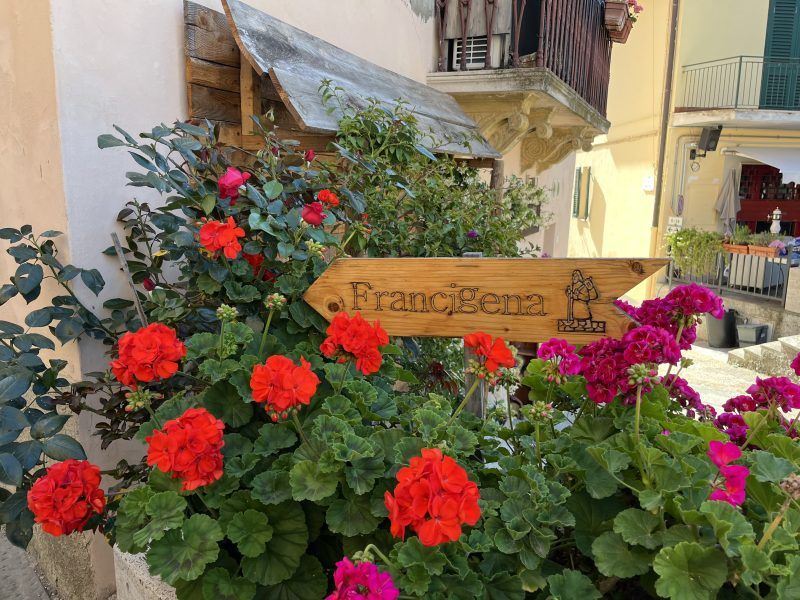
Hotels
Hotels can always be found everywhere, in all shapes and sizes. So also on the Via Francigena. Exactly for those looking for a bit more comfort, a private room and bathroom or more privacy. A hotel has a wide range of facilities, which is what you might need as a pilgrim.
During your walking holiday on the pilgrim’s route, you will find plenty of hotels. Some just a bit more luxuriously featured than others. That is why they are also a bit more expensive than a hostel. And therefore also provide a less communal pilgrim feeling.
Agriturismos in Italy
In Italy, they know exactly how this concept works. An agriturismo exudes peace, authenticity and friendliness in the charming (Italian) countryside. Literally taste the atmospheres, flavours and hospitality of the locals and be pampered. Last but not least, give your inner self some rest too. Often, these agriturismo are set amid olive groves, vineyards, while looking over rolling hills. They are hidden gems.
Literally, because to reach these accommodations you sometimes have to be just outside a village and thus walk some extra kilometres.
On the other hand, this is the perfect place to recharge and stay an extra night, for example. Swim in the pool, read a book in comfort, enjoy the view and delicious local food served. For all this, of course, you pay a price. But is, if you ask us, well worth it. This is a unique experience that will make your Via Francigena just a touch more special.
Monasteries and convents
Where to stay in Via Francigena: What the Via Francigena is famous for; the many monasteries and convents found along the pilgrimage route. These beautiful, historic buildings have been transformed occasionally into places to sleep which adds a special touch to your walking holiday. They provide tranquillity and a spiritual experience. Which, of course, a pilgrim can appreciate. Of course, to create all this, some rules apply.
For instance, you will have to abide by certain regulations at these accommodations. In addition, there are only a limited number of places available and you will have to settle for basic facilities. But is this all worth it to make your Via Francigena extra special and literally taste the pilgrims’ vibes.
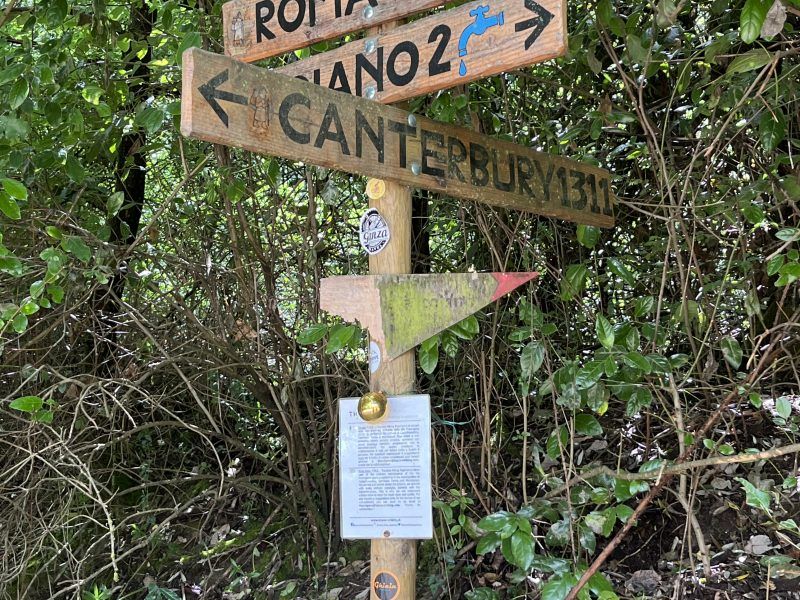
How to Choose the Best Place to Stay
Comfort vs. Budget
Some pilgrims prioritize comfort after a long walking stage, while others prefer to keep costs low. Agriturismos and hotels offer more luxury, while hostels and convents are ideal for budget travelers. Think about what matters most for your experience.
Proximity to the Route
Staying right on the Via Francigena saves energy and time. While some accommodations (like agriturismos) may be slightly off route, they can offer a unique and peaceful break—just factor in the extra distance when planning.
Booking in Advance
Accommodation availability varies depending on the country and season. In popular towns or peak months, it’s smart to book in advance—especially for B&Bs and agriturismos. For hostels or monasteries, flexibility is often possible, but not guaranteed.
Our Favourite Cities on the Via Francigena
As the Via Francigena is over 2,000 kilometres long, you pass quite a few cities, villages and other places. That is why we have listed our favourite places for you.
Canterbury
The place, where the Via Francigena begins. At the foot of the magnificent cathedral, this pilgrimage route starts. The perfect way to delve into history from here and quietly take in the pilgrim feeling. This mighty cathedral is a UNESCO world heritage site for a reason. Another UNESO gem is the Abbey of St Augustin.
Sleep in a cosy hotel, drink a cup of tea in a cosy tea room, have a beer among the locals in a pub, eat fish and chips and start the next day with a really hearty English breakfast. Although the last thing one is not for everyone.
Reims
On to France where Reims can be found in the middle of the Champagne region. This bustling city owes much history to both the First and Second World Wars. Its stately cathedral and archbishop’s palace are also worth a visit. If only for the fact that these are on the UNESO world heritage list. If you are a champagne lover, this is the place to be.
Taste a glass, or two, at one of the famous wineries such as Veuve Clicquot and learn all about this delicacy on one of the tours. Stay in an alberuge or hotel in the city itself. Or find a fine accommodation that is literally in the vineyards.
Besançon
Formerly known as Vesonito, a picture-perfect town because of its location on the banks of the Doubs river. Not to mention its rich history. In fact, this Gallo-Roman city used to be very important. Now you can still see the remains of this history such as the Porte Noire and a Roman theatre. You can stay here in charming hotels, but also in local guesthouses where the locals will welcome you with open arms.
Anyway, whatever your accommodation, ask about the restaurants where they serve local delicacies: cheeses like Comté or Morbier, coq au vin jaune or saucisse de Mortea.
Lausanne
A beautiful city located on Lake Geneva. Only when you look around you see breathtaking views. The mountains with their imposing (snow-capped) peaks, the blue weather and the medieval history that meets you in the city centre. Visit the Gothic cathedral or indulge your sports fanatic heart at the Olympic Museum. Stay in a luxurious boutique hotel, as real castles have been transformed into accommodation. Or go for the local atmosphere in one of the hotels or B&Bs that Lausanne offers.
And of course, enjoy Swiss gastronomy: raclette, fondue or all the other delicacies with Swiss cheeses. And of course, with the lake in your sights, a tasty fish is not to be missed with a matching glass of, local, wine.
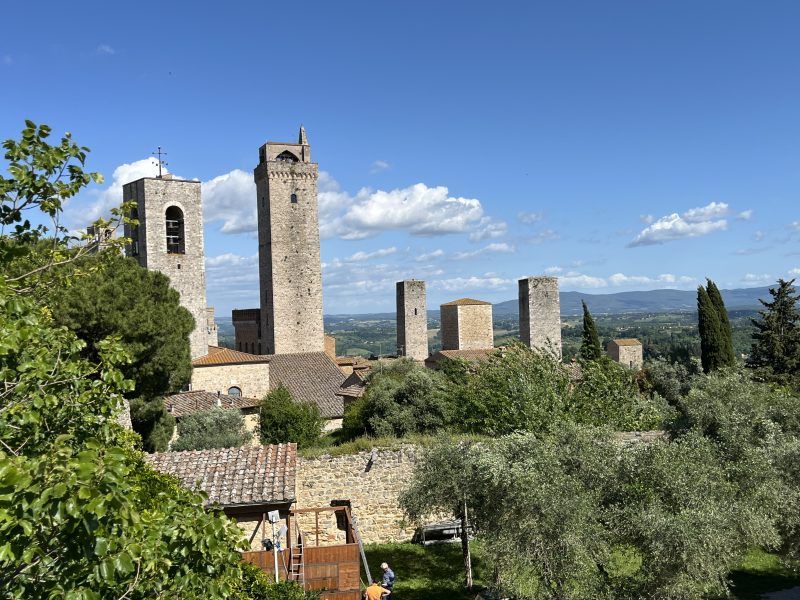
San Gimignano
A medieval gem located in beautiful Tuscany. San Gimignano’s skyline is stunning. And wandering through the medieval town centre will take you back in time. It is therefore no surprise that this is a UNESCO World Heritage Site. Enjoy your stay in one of the charming hotels. Or pamper yourself at one of the agritourisms where you can literally taste the Italian culture.
Siena
The city with its famous shell-shaped square, the site of the Palio di Siena horse race. An imposing Romanesque-Gothic-style cathedral with beautiful facades and frescoes and the (speckled) marble floors. This city is truly a gem to stroll leisurely through. Choose accommodation that suits you: a charming hotel, a local guesthouse, a cute B&B or go for more luxury and live ‘La Dolce Vita’ in one of the agriturismos among the vineyards.
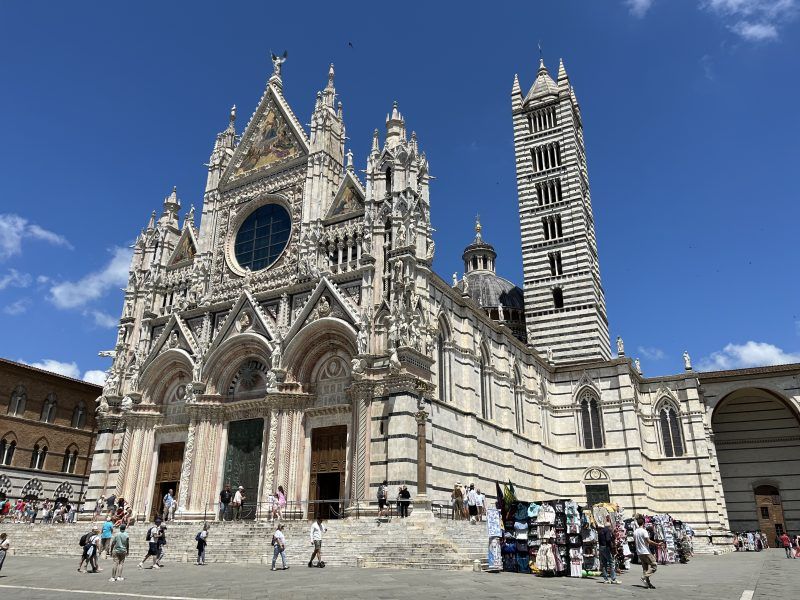
Local Tips for Your Stay
Having a chat with the locals, getting information that can’t be found in a booklet and stepping into the life of one the residents on the Via Francigena for a while. It makes your walking holiday just that little bit more special and gives you a unique feeling.
They know better than anyone else where to sleep, have a family member or friend who will welcome you with open arms and give you everything you need as a pilgrim. It is perhaps these chats with locals that make your walking holiday special. After all, they know the area like the back of their hand. Above all, don’t let the fact that you don’t speak the language hold you back.
We got hands and feet with which we can explain a lot and still speak a bit of the same language. Often, all this adds up to the nicest ‘game hints. And we now have a new ‘friend’ Google translate who will always help you if you can’t find the right words. So it is the best place where to stay in Via Francigena…
Where to stay in Via Francigena: Planning & Booking Advice
- You are not alone with the question: where to stay in Via Francigena, so we recommend booking your accommodation in advance. That way, you can be sure of your favourite spot and enjoy the day’s stage in peace and quiet. We will be happy to help you find suitable accommodation.
- Make use of your pilgrim’s passport. This is not only for putting your well-deserved stamps, but can also provide you with special pilgrim rates at one of the many accommodation establishments.
- Have a chat with one of the locals and find out what they recommend as accommodation. As natives and true connoisseurs of the area, they will not only know how to provide you with special information about the area, but will surely know how to direct you to one of their friends, family or acquaintances who will offer you a warm welcome. And don’t worry if you don’t speak the language. Hands and feet, work wonders, as does Google Translate.
- To make your pilgrimage route on the Via Francigena as unique as possible, where to stay in Via Francigena, the variety of accommodation is an absolute must. That way you can get a taste of everything. Although this of course depends on the budget you have to spend. However, you can find a way around everything.
The Via Francigena is not only a beautiful pilgrimage route to walk, but also offers gems to stay in. Enjoy hidden gems, live like and among locals, be welcomed with open arms, step into history or the ‘simple’ that is often enough too. From a charming B&B, to hostels where you share experiences with other pilgrims. Sleep in a piece of history, a monastery or monastery or pamper yourself at one of the agriturismos.
If you feel like walking the Via Francigena, take a look at this 8-day walk from Lucca to Siena. Or delve a little more into the ancient pilgrimage route the Via Francigena.
Still not sure which Camino to walk? Team WAW is here for you, so feel free to contact us and we will be happy to help you on your way.
How much does accommodation typically cost along the route?
Accommodation along the Via Francigena varies by country and type. Pilgrim hostels can cost around €10–20 per night, while small guesthouses or B&Bs usually range from €30–60. Hotels and private lodgings can be more expensive, especially in larger towns or cities.
Do I need to book accommodation in advance on the Via Francigena?
It depends on the season. During summer and popular sections in Italy, it’s recommended to book in advance to ensure availability. In less busy periods or rural areas, many pilgrims find accommodation on arrival, especially in hostels or parish lodgings.
What is the best city to start the Via Francigena with good lodging options?
Popular starting points with strong accommodation options include Lucca, Siena, and San Miniato in Italy, as they are well-connected and have a wide range of pilgrim-friendly lodging. For those walking the full route, Canterbury in England is the traditional starting city.


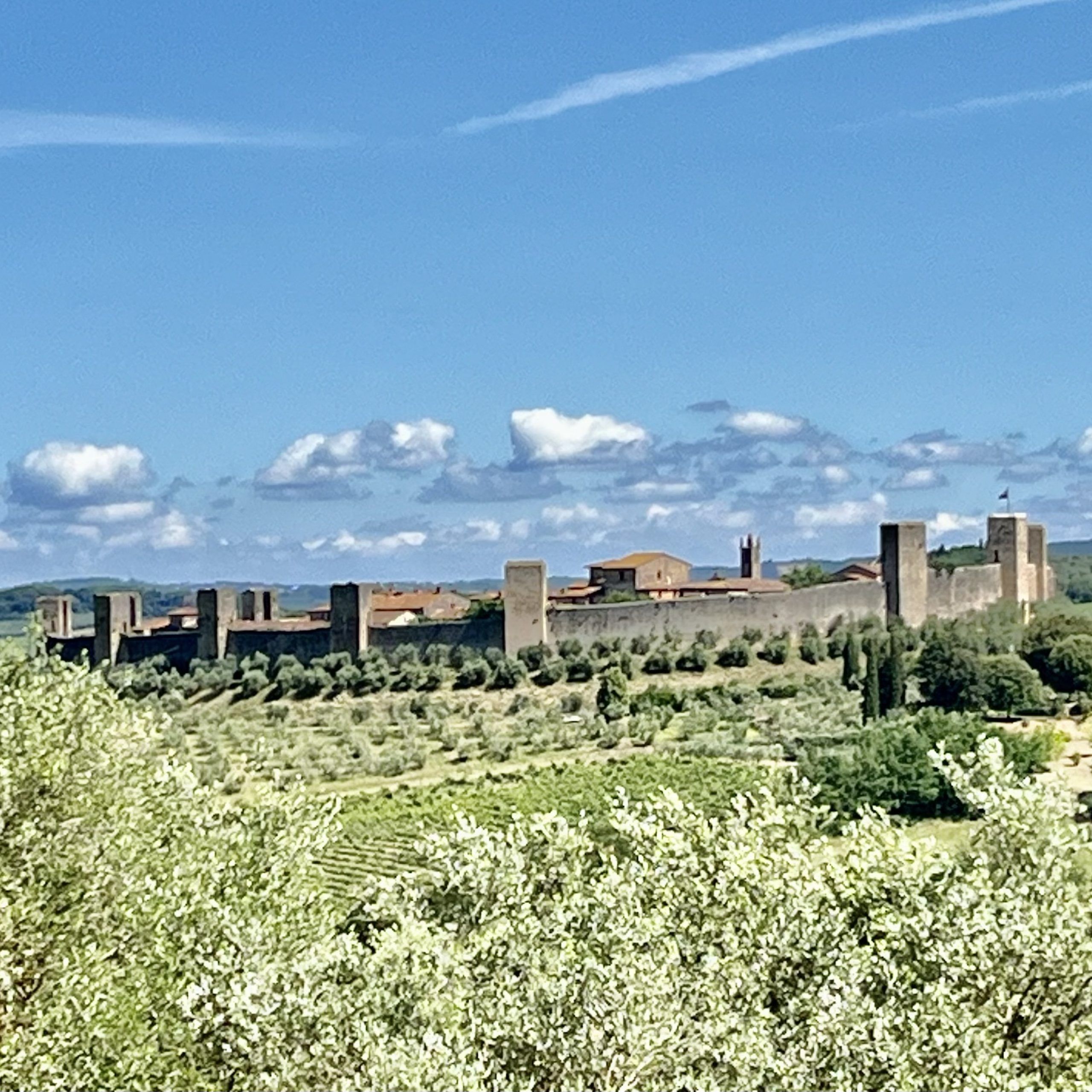
Comment (0)